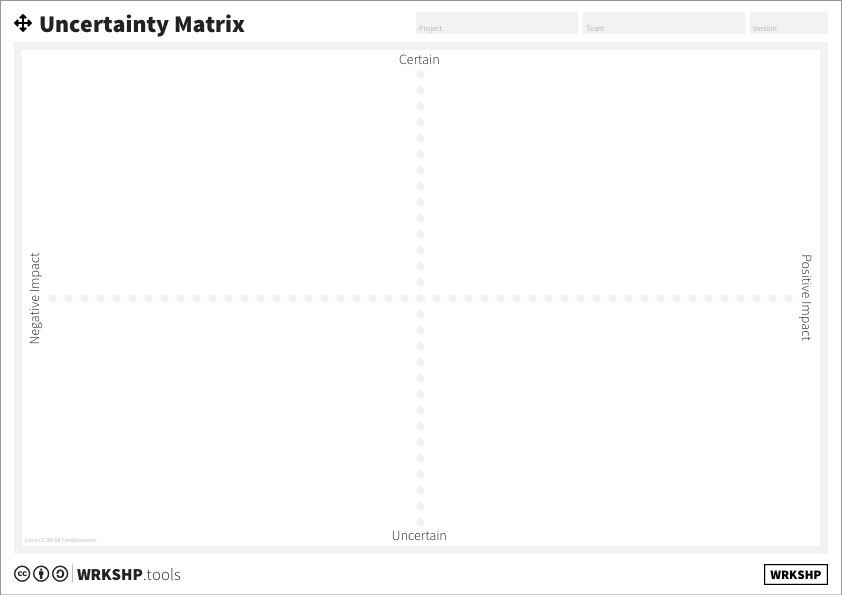Uncertainty Matrix
The Uncertainty Matrix helps you find threats and opportunities that are uncertain but can have a big impact on your business
Use this tool when:
- you want to find threats and opportunities that are uncertain but can have a big impact on your business
Overview
| Time | ± 30 minutes | |
| Difficulty | 2 / 5 | |
| People | 3 - 5 | |
| Author | erik van der pluijm | |
| Website | ||
| License | CC BY SA 4.0 |

What is it and when should I use it?
In any innovation process, uncertainty is a big thing. Most of what you are doing is uncertain. There are many assumptions and blind spots, there is no way around that.
Each of these assumptions or blind spots could have the potential to kill your startup or business. What about that new piece of legislation that you don't know about? Or your assumptions about your customer segment that are just plain wrong?
In the end, you'll need to experiment and validate to find out which assumptions are correct. Check out the Experiment Canvas for more on running experiments and validating. Blind spots are a bit harder, but the Trend Canvas can help you at least work towards eliminating them.
Knowing your assumptions and investigating your blind spots is one thing to do. But another, equally important step is to understand how much you know about them, and how big of an impact they may have on your business.
The Uncertainty Matrix helps you map assumptions and guesstimate the impact and uncertainty related to them, allowing you to make more informed decisions, and a direction to reduce uncertainty for the potentially high-impact ones.
Tool Overview

Negative Impact Things that have a negative impact on your business.
Positive Impact Things that have a positive impact on your business.
Certain Things you're certain about.
Uncertain Things you're uncertain about.
Less important Things that don't have much of a positive or negative impact and you're not certain or uncertain about.
Steps
1 Collect Assumptions
The first step is to collect the things you want to map. One great way of using this canvas is to find risky assumptions in combination with the Riskiest Assumption Canvas. Another excellent way to use it is to find out what trends and outside influences (e.g. competitors) to track, in combination with the Trend Canvas.Get a list of ±10-20 assumptions or trends together, and make sure you label each clearly on a post-it note.
If you are looking at trends, you'll first have to 'unpack' the trends into outcomes that may impact your business. For instance, the trend 'Machine Learning' is too broad to effectively map the impact for. You'll need to think a bit on the different outcomes that can be a result of this trend, for instance availability of algorithms, how it influences competition, the need for data to make effective use of Machine Learning, etc. Each trend might lead to ±3-5 of these 'outcomes'.
2 Map Impact
First, for each of the post-its you wrote, map them only on the 'impact' axis. It is usually easier to gauge the impact. Have team members pick each post-it, and place it on the horizontal central line where they think it should go. If a post-it has both positive and negative impacts, split it up and relabel it.
Have the person that places the post-it explain what it is and why they are placing it there.
3 Map Certainty
Next, have the team silently reshuffle the post-its on the vertical axis. They can move post-its up and down, reflecting how certain they think they are about them. If you don't agree on the vertical position, choose the lowest one (the most uncertain), as your disagreement reflects that uncertainty.
Things are most certain when you have proved them, either through an experiment (see Experiment Canvas), or, even better, by actual results. If you haven't done that, you're not allowed to but the post-it in the op third of the canvas!
4 Find high-impact
There are in essence 5 big groups that each post-it can end up in. Look at the checklist below, and find the post-its that you can either start work on today (how many did you not know about before today?), and the ones you really should work toward getting more certainty on. Start designing experiments (see Riskiest Assumption Canvas and Experiment Canvas) to reduce the uncertainty.
- Top left: Negative impact, high certainty. These are problems you should start to solve today.
- Top right: Positive impact, high certainty. Opportunities you can work on today
- Bottom left: Negative impact, high uncertainty. These are things to worry about. You'll need to start doing experiments that reduce the uncertainty.
- Bottom right: Positive impact, high uncertainty. These are things that might help you but you have not enough information about. You'll need to start doing experiments that reduce the uncertainty.
- Center: Post-its in the center are middle of the road, and probably not that interesting
5 Next Steps
Start designing experiments (see Riskiest Assumption Canvas and Experiment Canvas) to reduce the uncertainty for the high impact, high uncertainty items.